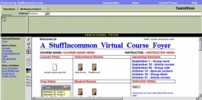TeamWave Retrospective
About this Site
This site offers a retrospective on some of the (at the time) innovative CSCW technologies that were developed at TeamWave. It serves as a place to gather articles etc. describing how systems such as Workplace were used.
This site is a personal work by Mark Roseman, and is in no way affiliated with Sonexis Inc. (who now own all the rights to the technology).
Brief Company Timeline
TeamWave Software Ltd. was formed in late 1996 by Mark Roseman, as a spin-off from research done at GroupLab at the University of Calgary. Using the TeamRooms prototype from U of C as a starting point, the TeamWave Workplace product was developed. Development shifted to web-based collaboration projects in 1998 (including the sites StuffIncommon.com and OneStopMeeting.com), on the strengths of which the company was sold to Boston-based Sonexis in late 2000 (see below).
Others who worked in the company were (in order of appearance): Brad Johnson, Fred Yee, Leo Pelland, Tom Kenworthy, Ted O'Grady, Raymond Yip, Derek Miao, Tayt Winitoy, Darren Shen, Judd Jurado.
TeamWave Workplace
TeamWave Workplace was TeamWave's original, client-server, downloadable product. Both client and server pieces ran on Windows, Mac and a variety of Unix platforms.
Workplace offered a flexible rooms-based collaboration environment supporting both real-time and asynchronous group work. Each room was centered around a large persistent whiteboard, which could hold not only drawings and text but also a variety of other tools. There were provisions for extending the system (e.g. adding new tools) through an SDK.
The system was popular for a wide range of uses, most importantly in education.
A good starting point for information about the system are the two original TeamRooms papers: user-oriented and technical.
Screenshots. Here are some overview screenshots (click for larger):


 .
.
Interesting uses. Here are a few pointers to some things other people have written about TeamWave Workplace:
- A great introductory paper describing TeamWave Workplace and its features by Wayne Richmond.
- DOCTA: A Norwegian project investigating collaborative telelearning. Interestingly, Workplace was just huge in Norway, in large part because of the work done by these folks. I'm sure it has nothing to do with the lead researcher having Canadian roots...
- One of the more interesting uses was by Mary Ellsworth at Gallaudet University, who was using TeamWave Workplace in the education of deaf students. Here's a getting started page at their site.
Web-Based Systems
TeamWave's later systems moved from being downloadable client-server software, to hosted web-based products.
The products still centered around a whiteboard, implemented using a thin-client Java technique, but added a broader hosting infrastructure to support large number of instances of the environment. Later systems also introduced more advanced features such as shared browsing, document sharing, and more.
StuffIncommon. The first web-based system was oriented towards virtual communities, providing a richer interaction environment than existing systems for music sharing, chat, etc. The system was offered as a freely available hosted service (ahh, the good old days of the dot-com user land grab), and customized versions were paired with offerings from companies such as WebCT.
OneStopMeeting and Beyond. The follow-on system was OneStopMeeting, which offered a more meeting oriented focus, introducing presentation support, meeting scheduling, and so on. This product was nearing completion when TeamWave was acquired. It became the basis (paired with an audio conferencing system) for the short-lived LearningVoice system, and later much of the technology evolved into parts of the netCollaborator product at Sonexis.
Screenshots. Here are a few screenshots, one from StuffIncommon and two from OneStopMeeting (click for larger):



Acquisition and Beyond
In mid-2000 Fred started shopping the company around, met with a number of potential acquirers, and we eventually sold that December to Sonexis (then called eYak). Led by the successful serial entrepreneurs David Friend and Jeff Flowers (who as of 2008 are the brains behind Carbonite). They hired the core team; most stayed in Calgary, Leo was still in Edmonton, and Mark in Hamilton (with direct flights to Alberta and Boston) was primarily the lucky go-between.
Sonexis was ridiculously well-financed, well positioned for a huge IPO (ahh the good old days), and had a very powerful and compelling audio conferencing technology. It was a perfect complement to the web conferencing technology TeamWave had, and so the idea was to integrate the two into a unified audio/web conferencing product. (The standalone Workplace product was of course of no interest, so was shelved).
The first combined product was targeted at education, called LearningVoice (a hosted service). With the tech bust well on its way, the company started switching directions, and at one point were looking to sell the TeamWave technology and crew off to someone else. Several changes of direction later, they switched focus to building a LAN-hosted conferencing appliance (originally called netCollaborator, later ConferenceManager), which again we were a part of.
Starting in 2002, as various "handcuffs" from the deal came off, and other opportunities presented themselves, the TeamWave guys who had been hired on at Sonexis left. ConferenceManager is still listed on their web site as their main product, though I have no idea what if anything might have changed since we left.
Oh, the financial side. There was some actual cash involved in the deal, but not a lot (mostly retention bonuses). As was common, most was shares and options "worth millions" at acquisition time (they were private of course, so that was just on paper). They'd previously raised enough money to still survive through the dot-com bust (unlike most companies, including the others who were interested in buying us earlier). But the company still contracted quite a bit, eventually swapped management teams, refinanced and restructured their shares. This shows what most holders of the millions of dollars of common stock ended up with (click for larger):
